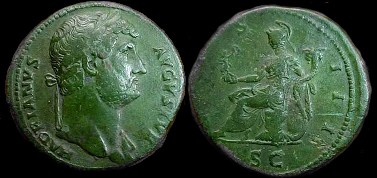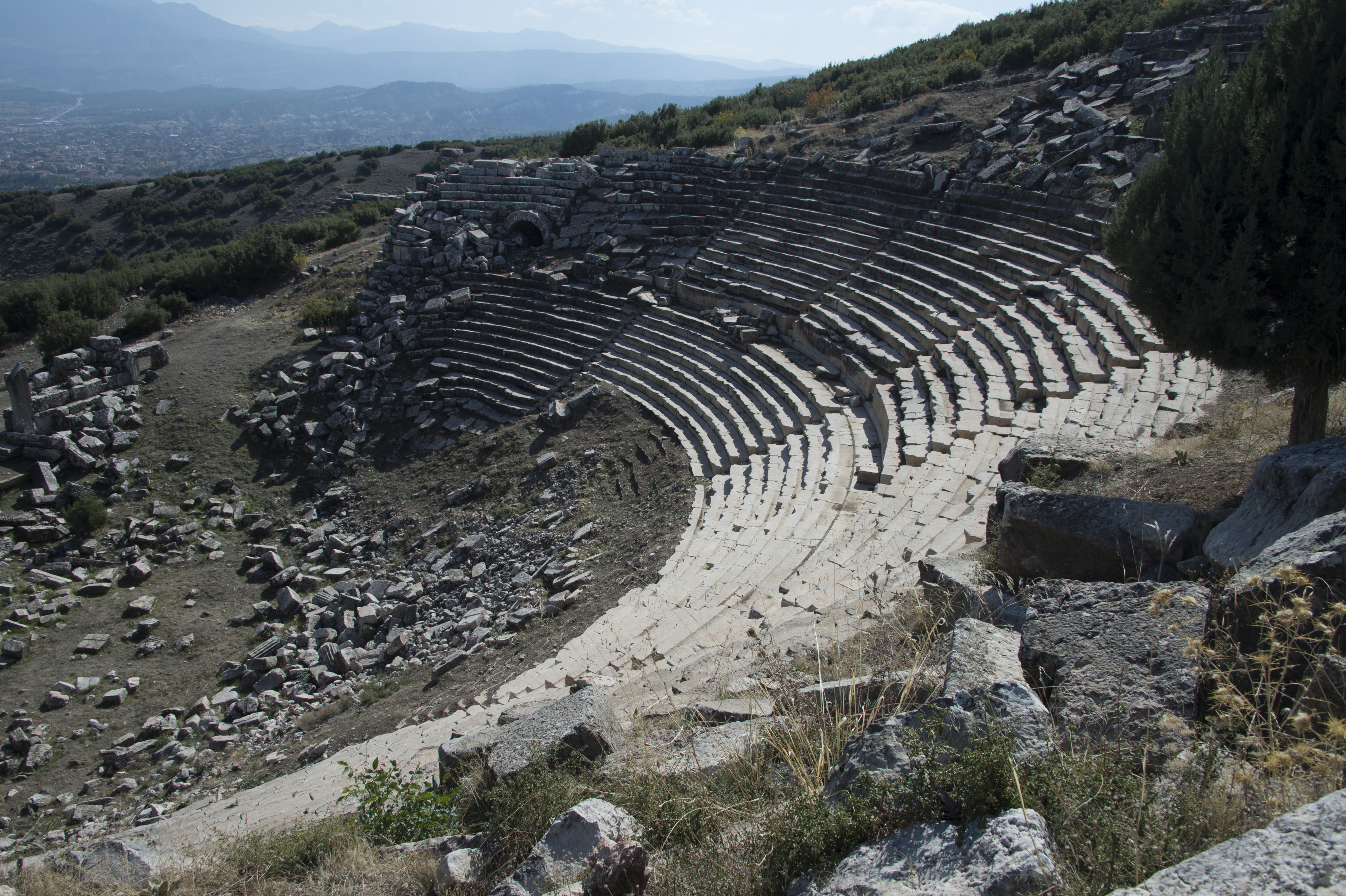|
AD 17 Lydia Earthquake
The AD 17 Lydia earthquake caused the destruction of at least twelve cities in the region of Lydia in the Roman province of Asia in Asia Minor (now part of Turkey). The earthquake was recorded by the Roman historians Tacitus and Pliny the Elder, and the Greek historians Strabo and Eusebius. Pliny called it "the greatest earthquake in human memory" (Nat. Hist. 2:86 §200). The city of Sardis, the former capital of the Lydian Empire, was the most affected and never completely recovered from the destruction. Damage Historical records list up to fifteen towns and cities that were destroyed or damaged by the earthquake: Sardis, Magnesia, Temnos, Philadelphia, Aegae, Apollonis, Mostene, Hyrkanis, Hierapolis, Myrina, Cyme, Tmolus, Pergamon, Ephesus and Kibyra. Of these, Pergamon, Ephesus and Kibyra are not mentioned by Tacitus. The record of damage at both Ephesus and Kibyra may refer instead to an earthquake in AD 23. In Pergamon the Heroon of Diodoros Pasparos was remodelled aft ... [...More Info...] [...Related Items...] OR: [Wikipedia] [Google] [Baidu] |
Hyrcanis (Lydia)
Hyrcanis or Hyrkaneis, also known as Hyrcania ( grc, Ὑρκανία), was a Roman and Byzantine-era city and bishopric in ancient Lydia, now in western Turkey. It was situated in the Hyrcanian plain (τὸ Ὑρκάνιον πεδίον), which is said to have derived its name from a colony of Hyrcanians being settled here by the Persians. They were afterwards mingled with some Macedonians, who also settled in this district, whence they are called by Pliny the Elder and Tacitus "Macedones Hyrcani." The city minted its own coins. Its site is located west of Halit Paşa in Anatolia, Asiatic Turkey, south of :tr:Çamlıyurt, Saruhanlı, Çamlıyurt. The city was also the seat of an ancient bishopric In church governance, a diocese or bishopric is the ecclesiastical district under the jurisdiction of a bishop. History In the later organization of the Roman Empire, the increasingly subdivided provinces were administratively associate .... Known bishops include: *Asyncr ... [...More Info...] [...Related Items...] OR: [Wikipedia] [Google] [Baidu] |
Julius Caesar
Gaius Julius Caesar (; ; 12 July 100 BC – 15 March 44 BC), was a Roman general and statesman. A member of the First Triumvirate, Caesar led the Roman armies in the Gallic Wars before defeating his political rival Pompey in a civil war, and subsequently became dictator from 49 BC until his assassination in 44 BC. He played a critical role in the events that led to the demise of the Roman Republic and the rise of the Roman Empire. In 60 BC, Caesar, Crassus and Pompey formed the First Triumvirate, an informal political alliance that dominated Roman politics for several years. Their attempts to amass power as were opposed by the within the Roman Senate, among them Cato the Younger with the frequent support of Cicero. Caesar rose to become one of the most powerful politicians in the Roman Republic through a string of military victories in the Gallic Wars, completed by 51 BC, which greatly extended Roman territory. During this time he both invaded Britain and built a b ... [...More Info...] [...Related Items...] OR: [Wikipedia] [Google] [Baidu] |
Praetor
Praetor ( , ), also pretor, was the title granted by the government of Ancient Rome to a man acting in one of two official capacities: (i) the commander of an army, and (ii) as an elected '' magistratus'' (magistrate), assigned to discharge various duties. The functions of the magistracy, the ''praetura'' (praetorship), are described by the adjective: the ''praetoria potestas'' (praetorian power), the ''praetorium imperium'' (praetorian authority), and the ''praetorium ius'' (praetorian law), the legal precedents established by the ''praetores'' (praetors). ''Praetorium'', as a substantive, denoted the location from which the praetor exercised his authority, either the headquarters of his '' castra'', the courthouse (tribunal) of his judiciary, or the city hall of his provincial governorship. History of the title The status of the ''praetor'' in the early republic is unclear. The traditional account from Livy claims that the praetorship was created by the Sextian-Licinian Rogatio ... [...More Info...] [...Related Items...] OR: [Wikipedia] [Google] [Baidu] |
Sestertius
The ''sestertius'' (plural ''sestertii''), or sesterce (plural sesterces), was an Ancient Rome, ancient Roman Roman currency, coin. During the Roman Republic it was a small, silver coin issued only on rare occasions. During the Roman Empire it was a large brass coin. The name ''sestertius'' means "two and one half", referring to its nominal value of two and a half ''as (Roman coin), asses'' (a bronze Roman coin, singular ''as''), a value that was useful for commerce because it was one quarter of a denarius, a coin worth ten ''asses''. The name is derived from ''semis'', "half" and "tertius", "third", in which "third" refers to the third ''as'': the sestertius was worth two full ''asses'' and half of a third. English-language sources routinely use the original Latin form ''sestertius'', plural ''sestertii''; but older literature frequently uses ''sesterce'', plural ''sesterces'', ''terce'' being the English equivalent of ''tertius''. A modern shorthand for values in sestertii i ... [...More Info...] [...Related Items...] OR: [Wikipedia] [Google] [Baidu] |
Tiberius
Tiberius Julius Caesar Augustus (; 16 November 42 BC – 16 March AD 37) was the second Roman emperor. He reigned from AD 14 until 37, succeeding his stepfather, the first Roman emperor Augustus. Tiberius was born in Rome in 42 BC. His father was the politician Tiberius Claudius Nero and his mother was Livia Drusilla, who would eventually divorce his father, and marry the future-emperor Augustus in 38 BC. Following the untimely deaths of Augustus' two grandsons and adopted heirs, Gaius and Lucius Caesar, Tiberius was designated Augustus' successor. Prior to this, Tiberius had proved himself an able diplomat, and one of the most successful Roman generals: his conquests of Pannonia, Dalmatia, Raetia, and (temporarily) parts of Germania laid the foundations for the empire's northern frontier. Early in his career, Tiberius was happily married to Vipsania, daughter of Augustus' friend, distinguished general and intended heir, Marcus Vipsanius Agrippa. They had a son, Drusus Jul ... [...More Info...] [...Related Items...] OR: [Wikipedia] [Google] [Baidu] |
National Geophysical Data Center
The United States National Geophysical Data Center (NGDC) provided scientific stewardship, products and services for geophysical data describing the solid earth, marine, and solar-terrestrial environment, as well as earth observations from space. In 2015, NGDC was merged with the National Climatic Data Center (NCDC) and the National Oceanographic Data Center (NODC) into the National Centers for Environmental Information (NCEI). Location and controlling bodies The NGDC, was located in Boulder, Colorado as a part of the US Department of Commerce (USDOC), National Oceanic & Atmospheric Administration (NOAA), National Environmental Satellite, Data and Information Service (NESDIS). Data holdings NGDC's data holdings contained more than 300 digital and analog databases, some of which were very large. As technology advanced, so did the search for more efficient ways of preserving these data. This data is now maintained by the NCEI. Data contributors NGDC worked closely with contri ... [...More Info...] [...Related Items...] OR: [Wikipedia] [Google] [Baidu] |
Kibyra
Cibyra or Kibyra (Greek: ), also referred to as Cibyra Magna, was an Ancient Greek city near the modern town of Gölhisar, in Burdur Province. It lay outside the north-western limits of the ancient province of Lycia and was the chief city of an independent state known as Cibyratis. Location The site is identified by its inscriptions. The Cibyratic plain is about 300 m above sea level. Cibyratis comprised the highest part of the basin of the Xanthus (river), and all the upper and probably the middle part of the basin of the Indus river, for Strabo describes Cibyratis as reaching the Rhodian Peraea. Mount Cragus ( Babadağ) at 6500 feet bounded it on the west and separated it from Caria. Pliny's brief description states that the river Indus, which rises in the hills of the Cibyratae, has sixty perennial contributories. History The city is mentioned by ancient literary sources. According to Strabo, the Cibyratae ( grc, Κιβυρᾶται) were said to be descendants of Ly ... [...More Info...] [...Related Items...] OR: [Wikipedia] [Google] [Baidu] |
Ephesus
Ephesus (; grc-gre, Ἔφεσος, Éphesos; tr, Efes; may ultimately derive from hit, 𒀀𒉺𒊭, Apaša) was a city in ancient Greece on the coast of Ionia, southwest of present-day Selçuk in İzmir Province, Turkey. It was built in the 10th century BC on the site of Apasa, the former Arzawan capital, by Attica, Attic and Ionians, Ionian Greek colonists. During the Classical Greece, Classical Greek era, it was one of twelve cities that were members of the Ionian League. The city came under the control of the Roman Republic in 129 BC. The city was famous in its day for the nearby Temple of Artemis (completed around 550 BC), which has been designated one of the Seven Wonders of the Ancient World. Its many monumental buildings included the Library of Celsus and a theatre capable of holding 24,000 spectators. Ephesus was recipient city of one of the Pauline epistles; one of the seven churches of Asia addressed in the Book of Revelation; the Gospel of John may have b ... [...More Info...] [...Related Items...] OR: [Wikipedia] [Google] [Baidu] |
Pergamon
Pergamon or Pergamum ( or ; grc-gre, Πέργαμον), also referred to by its modern Greek form Pergamos (), was a rich and powerful ancient Greece, ancient Greek city in Mysia. It is located from the modern coastline of the Aegean Sea on a promontory on the north side of the river Caicus (modern-day Bakırçay) and northwest of the modern city of Bergama, Turkey. During the Hellenistic period, it became the capital of the Kingdom of Pergamon in 281–133 BC under the Attalid dynasty, who transformed it into one of the major cultural centres of the Greek world. Many remains of its monuments can still be seen and especially the masterpiece of the Pergamon Altar. Pergamon was the northernmost of the seven churches of Asia cited in the New Testament Book of Revelation. The city is centered on a mesa of andesite, which formed its acropolis. This mesa falls away sharply on the north, west, and east sides, but three natural terraces on the south side provide a route up to th ... [...More Info...] [...Related Items...] OR: [Wikipedia] [Google] [Baidu] |
Tmolus (town)
Aureliopolis in Lydia (Ancient Greek: Αυρηλιούπολις Λυδίας) is a city in the Roman province of Lydia, previously called Tmolus or in Greek Τμῶλος (Tmolos). It issued coinage under each of these names, and one coin combines both names. In the Synecdemus it appears as Auliou Kome. The name "Aureliopolis" was given in honour of the emperor Marcus Aurelius. History It was a town of ancient Lydia, situated on Mount Tmolus, and was destroyed during the Lydia earthquake, otherwise known as the Earthquake of the Twelve Cities, in 17 CE. Some coins are extant with the inscription Τμωλείτων, but the actual minting of the coins issued in its name may have been done in the more important neighbouring city of Sardis. Bishop Aureliopolis was the site of an early bishopric and the names of five of its ancient bishops are preserved in a number of documents. *Antiochus took part in the First Council of Nicaea in 325 *John participated actively in the Council of E ... [...More Info...] [...Related Items...] OR: [Wikipedia] [Google] [Baidu] |







_-_Turkey_-_10_(5747249729).jpg)